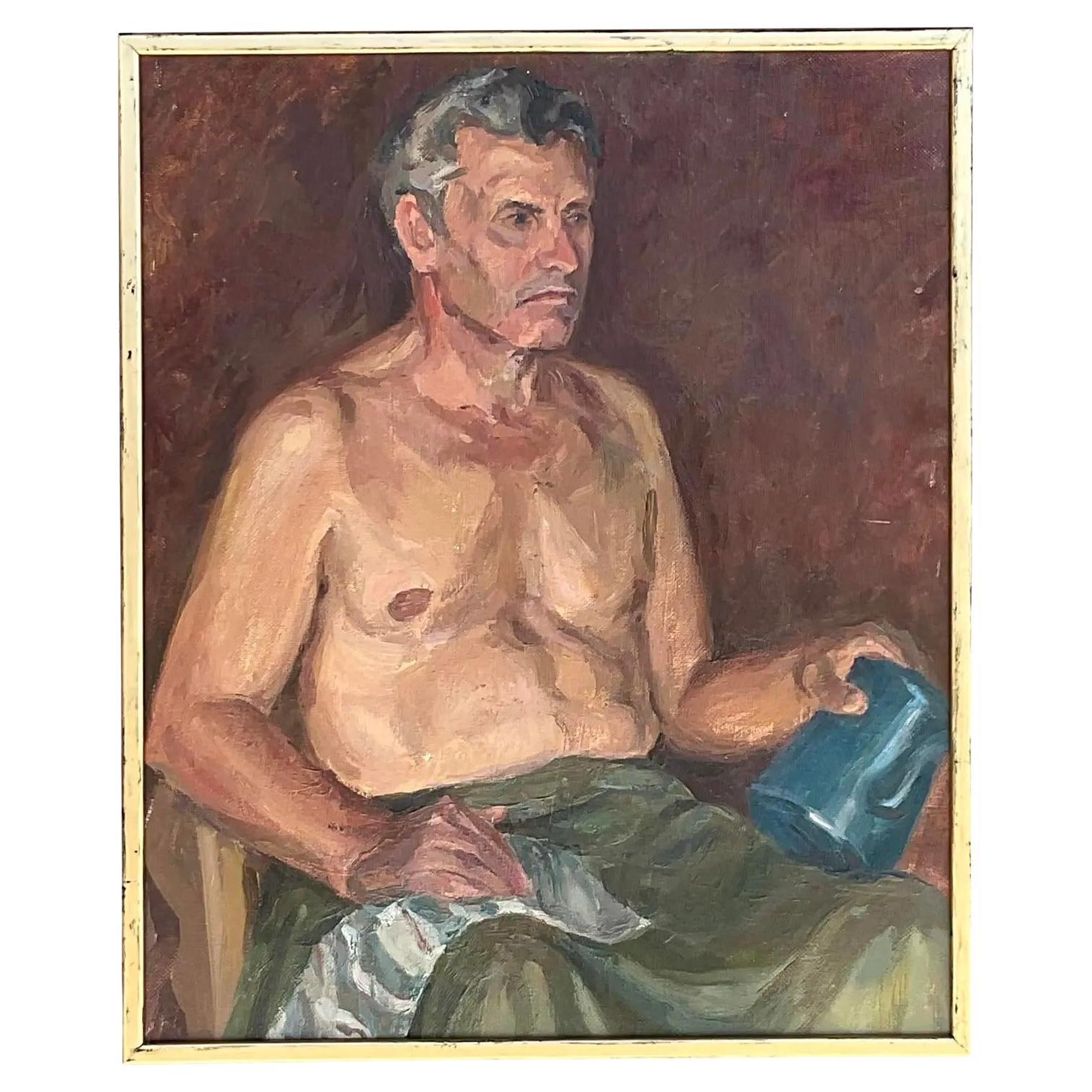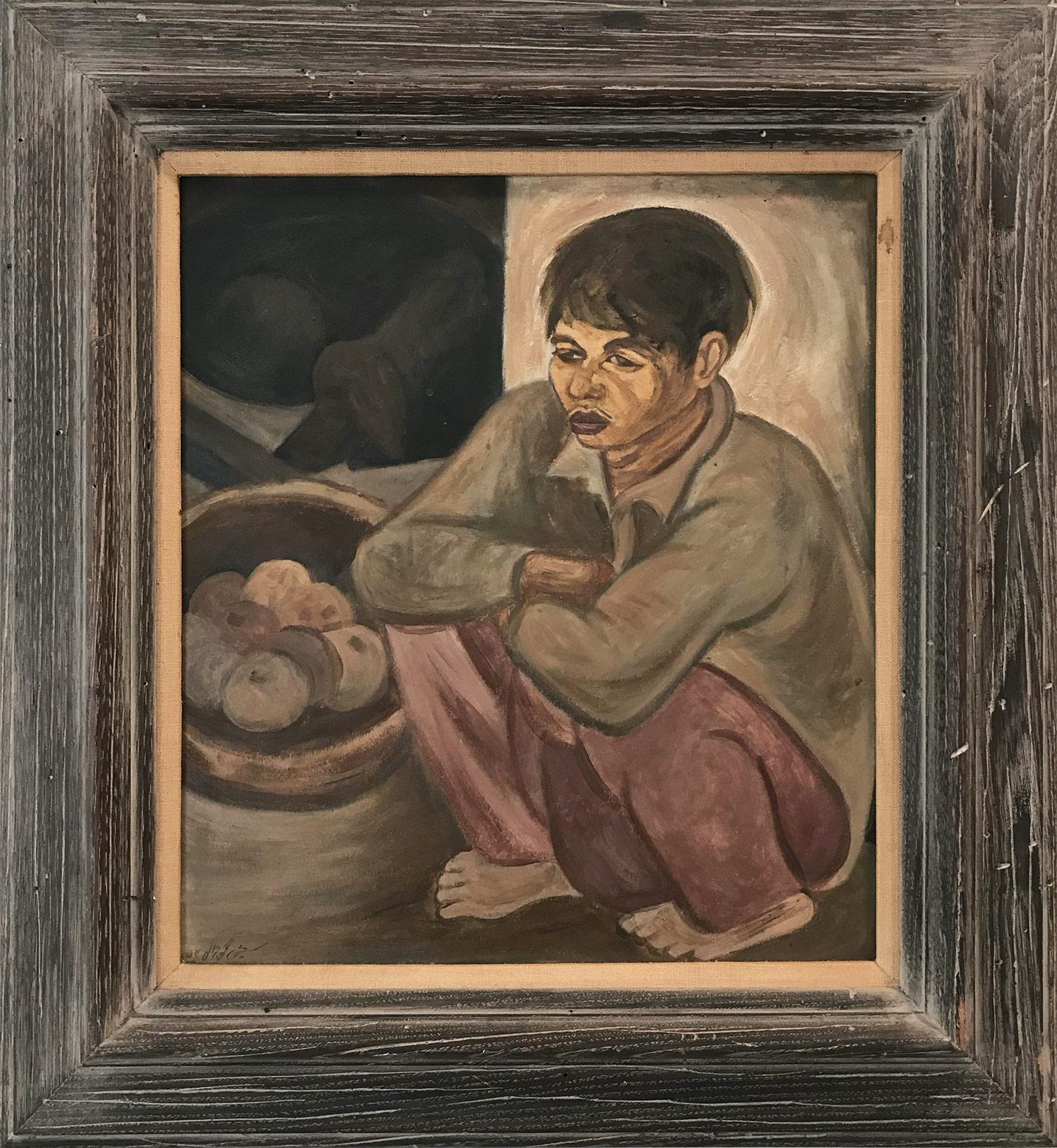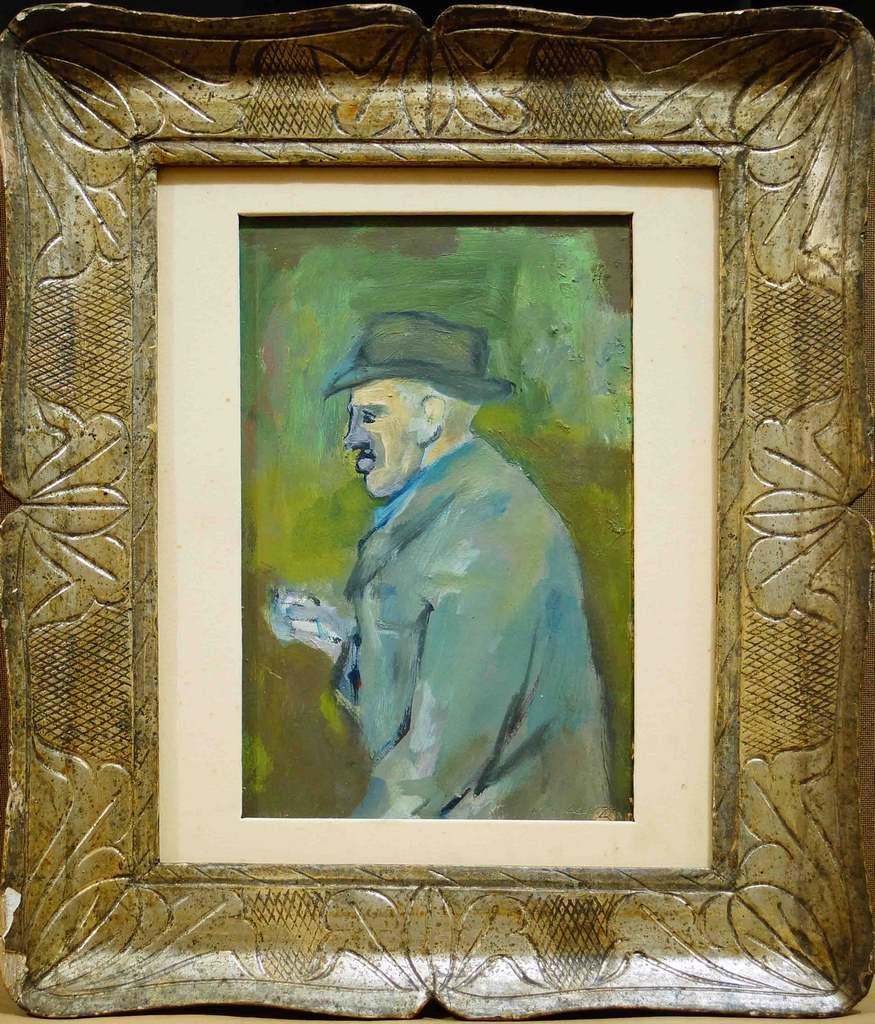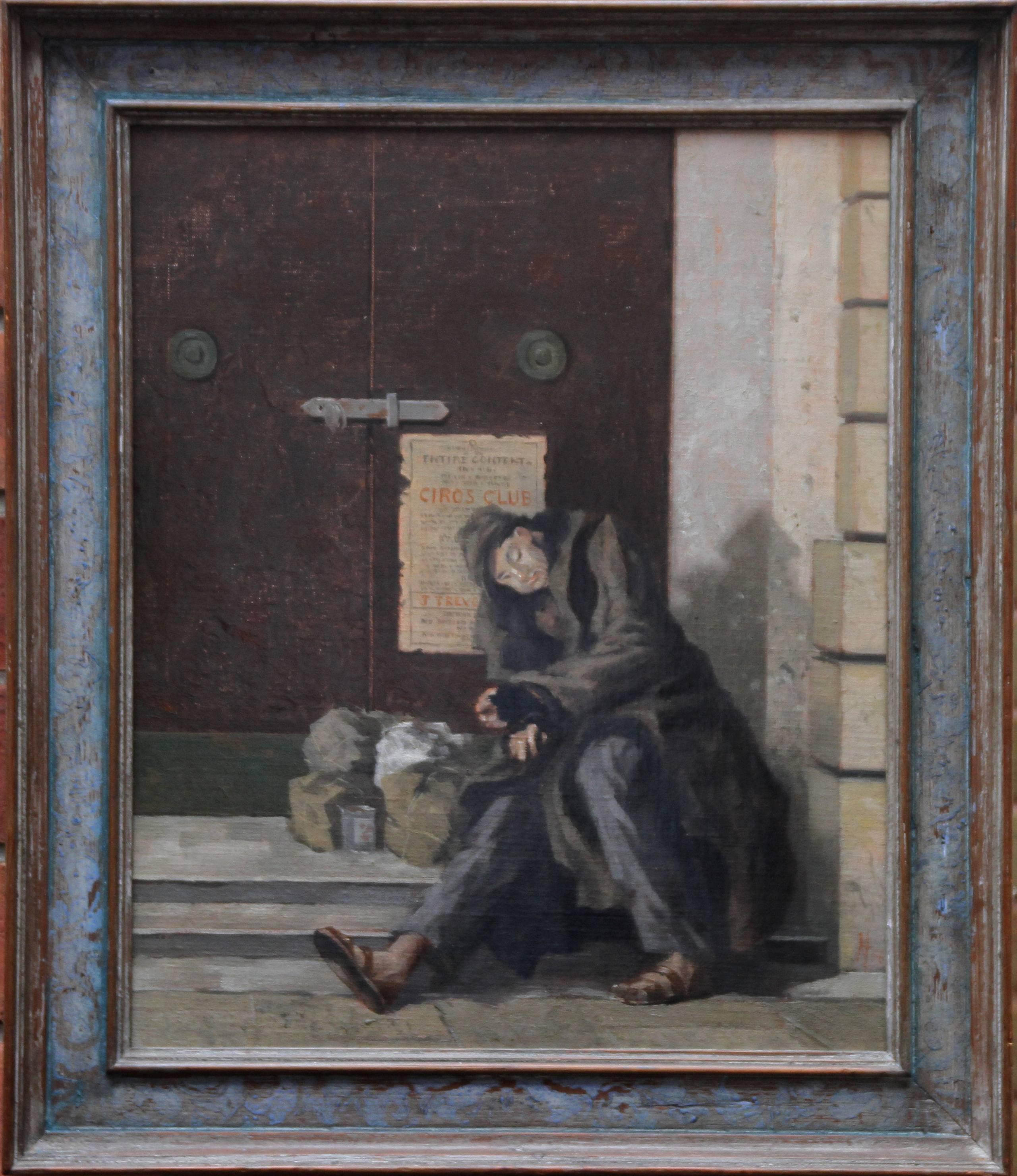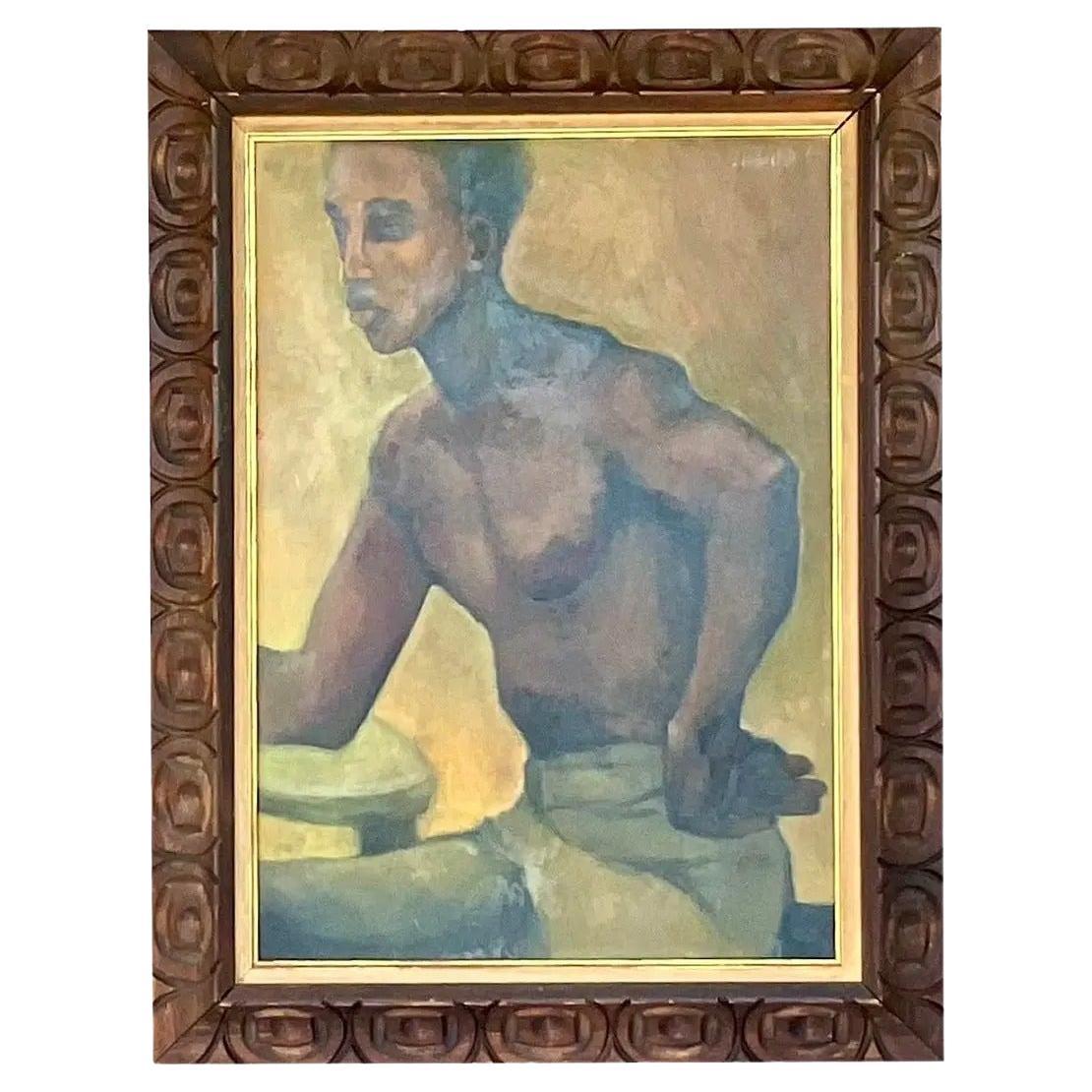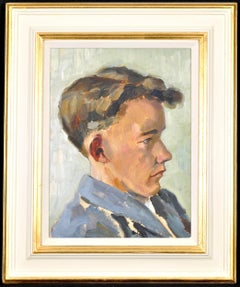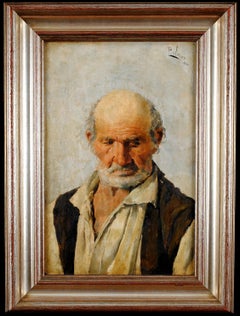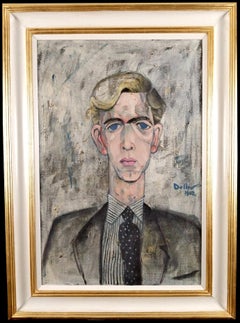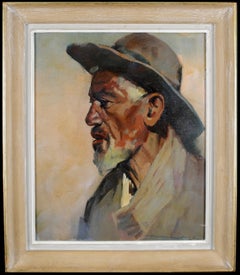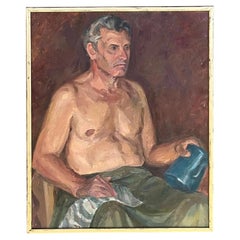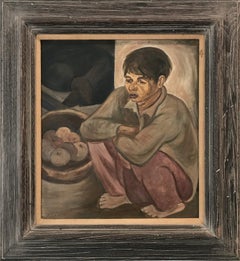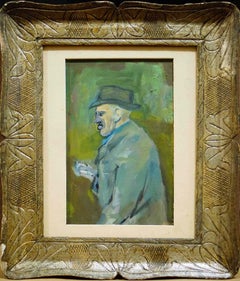Items Similar to Man with a Bowl - Mid 20th Century Modern British Portrait Oil Painting
Want more images or videos?
Request additional images or videos from the seller
1 of 15
Robert FarquharMan with a Bowl - Mid 20th Century Modern British Portrait Oil Paintingc.1960
c.1960
$1,301.66
£950
€1,108.12
CA$1,782.95
A$1,983.03
CHF 1,035.47
MX$24,131.31
NOK 13,224.59
SEK 12,402.33
DKK 8,270.35
Shipping
Retrieving quote...The 1stDibs Promise:
Authenticity Guarantee,
Money-Back Guarantee,
24-Hour Cancellation
About the Item
A superb mid 20th century modern British oil on canvas portrait of a man with a bowl, by Robert Farquhar.
The artist is very interesting - an artistic genius who spent 32 years in prison, he won several art prizes and gained several high profile patrons, including Sir Hugh Casson, president of the Royal Academy.
The work is highly original and possibly depicts a chef. Signed lower right and in very good condition.
Artist: Robert Farhuqar (British, b. 1937)
Title: Man with a Bowl
Medium: Oil on canvas
Size: 26.5 x 15 inches (68 x 38 cm)
During his 32 years in jail for jewellery and antiques thefts, Bob Farquhar's artistic talent was recognised and nurtured. He won awards and the backing of a host of patrons, including a former president of the Royal Academy.
On leaving prison for the final time 25 years ago, he set up a London gallery but 10 years ago he vanished and stopped painting. Now an exhibition of 20 newly commissioned paintings by Farquhar is to open in a gallery on the south coast thanks to the dogged belief of a woman who delivered a takeaway meal to him in a one-room "hovel" and noticed photocopies of his work hanging above his bed.
Farquhar served many sentences of four, six and seven years. As a young burglar he could, said a fellow ex-prisoner admiringly, "run up the side of a building". By his own account he was totally amoral: in his brief bursts of freedom, his aim was to live life in the fast lane – "Have now and pay tomorrow, I didn't care. I didn't consider it."
If that had been all there was to Farquhar, his story would have faded as the ex-cons with whom he shared the years inside died off. But Farquhar could paint. He also had an exceptional IQ. "With a different background," the head of education at one prison told him, "you could have been an academic."
Farquhar, a half Gypsy, was married for five years to Sylvie, a ballerina and solicitor's daughter, with whom he lived in a furniture van. He picked hops, worked on farms, sold watercolours, but Sylvie couldn't take "doing her toilet in the woods". She stood to inherit £4m, but only if she divorced him. Farquhar was reconvicted, and Sylvie broke her promise to wait for him and remarry. Later he had two children – both still teenagers whom he sees – by another woman.
By the time he was released for the final time in 1985, he had won three Koestler awards, presented to prisoners for exceptional art created in jail. He had also gathered an array of patrons, including the late Sir Hugh Casson, president of the Royal Academy and chairman of the Koestler Trust, who – according to his daughter, Carola Zogolovitch – admired Farquhar's "anarchic" spirit and his pictures that conveyed "the claustrophobia of prison life".
Supported by backers like Casson, Farquhar ran a gallery-cum-hostel for ex-prisoners near Waterloo in London. He himself became a Koestler judge touring prisons. Even then he was scarcely conventional: visitors recall a bucket in his office used as a chamber pot – "it was four floors up to the toilet", he explains. When his landlord wanted a share in the gallery, Farquhar moved on, roaming England in a London taxi, his home for a year.
Then 10 years ago, Farquhar disappeared. That is, until last August when Josie O'Rourke, a bookie's manager and former private eye, was asked by a friend who runs a cafe to deliver a meal to a "miserable old sod – he doesn't speak".
At first, she thought the ground-floor bedsit was derelict, but she discovered a "little old man with a beard". He answered all her questions with staccato "yeps".
Hanging from a string above the bed were photocopies of paintings that caught her attention. Having established that Farquhar was the artist, she found that she could not get him out of her head. She returned and gradually built up a rapport, persuading Farquhar to let her hawk his dog-eared portfolios round local art galleries. All his originals had long since been sold or given away.
From the Yellow Pages she drew up a list of galleries, among them the Hastings Arts Forum in East Sussex. The Forum is a membership gallery to which 500 local artists belong and a catalyst for arts activity. It was the perfect match: the volunteer manning the gallery that day, Sid Benyon, had himself been inside.
The Forum chairman, Tony Lyons, ex-army officer and Kensington antiques dealer, gave the thumbs-up, and the gallery's "angels" agreed to bear the cost of hiring the space. The gallery committee liked Farquhar's paintings of prisoners and prostitutes in King's Cross who had sheltered him when he was on the run.
Farquhar set to work to create 20 large paintings for an exhibition that opens this month. He had not touched a brush in nine years, but has slowly recaptured both his enthusiasm and his skill. O'Rourke scoured Hastings, finding sponsors for materials and frames.
Farquhar, now 73, is a poignant figure, bent over by a twisted nerve in his spine (he has an electric buggy and needs a stick to walk). He has a straggly beard and his hair is tied in a ponytail. His messy room is redeemed by the canvases he is working on and a small photograph of Arthur Koestler.
Farquhar was in a children's home at nine; Wormwood Scrubs prison at 14, sewing mailbags while waiting to be transferred to a detention centre. He played truant during the Blitz (his home was the Thames estuary town of Erith); learned to read and write aged 20 during his first long sentence. Later he teamed up with another prison artist, the late Jim Gilbert, to rob churches and even Wells Cathedral.
The pair came together through an arts charity set up to support former prisoners. Gilbert, at 6ft 4in, was a forceful, imposing man, with a string of sexual conquests. He landed them both with seven-year sentences when the police found a map on which Gilbert had neatly ringed all the churches they had robbed.
"Jim was a bully," says Farquhar. "I wouldn't have gone on a desert island with him."
Despite his own failure over 50 years to take advantage of his brains and talent – he went to art school at one stage and had a Cork Street gallery show – Farquhar has utter faith in the redemptive power of art.
"I've seen terrible villains whose lives changed when they picked up a brush: they are not villains any more," he says. "I believe in what the Koestler Trust is about – helping people."
Farquhar's paintings are penetrating, almost surreal, reminders of the thin divide between inside jail and out. There is a fraudulent city gent, half in prison garb and the other half in a suit with umbrella beside him, and beyond the bars a moonlit St Paul's and the City; a wrongly convicted prisoner next to Edvard Munch's Scream; men waiting in predawn gloom to be "ghosted" to other jails. Farquhar knew the lonely hours counting bricks in his cell wall, and it shows.
Could he have done differently? He dodges the question but says he would advise any young person at risk of wasting his life to "learn, read and study and listen to classical music – it touches the soul and makes us question who we are and where we are going. There's more to life than gold chains and Bentleys."
O'Rourke says Farquhar is a changed man since he picked up his brushes again – his mental and spiritual resurrection is "like Lazarus". Gone are the monosyllabic answers, replaced by an articulate analysis of his own and other ruined lives.
He is thankful to be back in the wider world, rescued by the chance delivery of a café meal. "I'll meet again old friends who once believed in me," he said of his coming exhibition. "A lot of people have my paintings. Maybe I'll get a West End show like I had years ago."
About the Seller
5.0
Platinum Seller
Premium sellers with a 4.7+ rating and 24-hour response times
Established in 2016
1stDibs seller since 2022
123 sales on 1stDibs
Typical response time: 1 hour
- ShippingRetrieving quote...Shipping from: Sevenoaks, United Kingdom
- Return Policy
Authenticity Guarantee
In the unlikely event there’s an issue with an item’s authenticity, contact us within 1 year for a full refund. DetailsMoney-Back Guarantee
If your item is not as described, is damaged in transit, or does not arrive, contact us within 7 days for a full refund. Details24-Hour Cancellation
You have a 24-hour grace period in which to reconsider your purchase, with no questions asked.Vetted Professional Sellers
Our world-class sellers must adhere to strict standards for service and quality, maintaining the integrity of our listings.Price-Match Guarantee
If you find that a seller listed the same item for a lower price elsewhere, we’ll match it.Trusted Global Delivery
Our best-in-class carrier network provides specialized shipping options worldwide, including custom delivery.More From This Seller
View AllPortrait of a Young Man - Modern British Impressionist Oil on Board Painting
Located in Sevenoaks, GB
* No US duty or taxes to pay on this item *
A beautiful 1950's Modern British oil on board portrait of a young man wearing a blue jacket. Excellent quality portrait which is present...
Category
1950s Portrait Paintings
Materials
Oil, Board
Portrait of a Man - 19th Century Spanish Antique Oil on Panel Painting
Located in Sevenoaks, GB
A fine signed and dated 1880 Spanish oil on panel portrait of a man wearing a white shirt and waistcoat by Manuel Pla y Valor. The work is superbly ...
Category
1880s Realist Portrait Paintings
Materials
Oil, Panel
Portrait of a Young Man - Large Modern British Figurative Oil on Canvas Painting
Located in Sevenoaks, GB
* No US duty or taxes to pay on this item *
A superb large scale Modern British oil on canvas portrait of a smartly dressed young man wearing a striped shirt, suit jacket and tie.
...
Category
1960s Portrait Paintings
Materials
Canvas, Oil
Portrait of a Black Man - Mid 20th Century French Oil on Canvas Painting
Located in Sevenoaks, GB
A very interesting 1960's French oil on canvas portrait of a black man wearing a hat. The work is superbly painted and in very good original condition. Indistinctly signed lower righ...
Category
1960s Portrait Paintings
Materials
Canvas, Oil
Man with Pipe - 19th Century French Impressionist Smoking Portrait Oil Painting
Located in Sevenoaks, GB
A superb late 19th century French impressionist oil on board portrait of a man with a pipe. Painted with short and fast brush strokes by a highly competent artist.
A striking period...
Category
1890s Impressionist Portrait Paintings
Materials
Oil
Plant in a Pot - Mid 20th Century French Modernist Cubist Still Life Painting
Located in Sevenoaks, GB
A beautiful, large modernist cubist influence oil on canvas still life with potted plant by French artist Jef Friboulet. Striking and excellent quality work, presented in a box frame...
Category
1960s Modern Still-life Paintings
Materials
Canvas, Oil
You May Also Like
Vintage Boho Signed Original Oil Portrait of Man
Located in West Palm Beach, FL
A fabulous vintage Boho original oil portrait on board. A chic composition of a handsome shirtless man. Deep rich color dominate the piece. Acquired from...
Category
Late 20th Century North American Paintings
Materials
Paint
Seated Man Portrait, Large Modernist Oil Painting WPA Artist
By Nahum Tschacbasov
Located in Surfside, FL
Nahum Tschacbasov was born in Baku, in the southeast of Russia. When he was eight years old, he came to America, where his family settled in Chicago.
His career, spanning more than five decades from the 1930’s to the 1980’s, is a kaleidoscope of influences, from modernism to the Byzantine style and expressionism of his Russian roots.
Tschacbasov’s paintings of the 1930’s reflect the social and political preoccupations of the times. He received considerable critical attention for his powerful dramatic satirical depiction of social injustice.
In the 1940’s he gained wider recognition when his style evolved into a fusion of Cubism and Surrealism. Through the influence of Jung, as well as currents brought to America by the newly arrived group of European Surrealists, he created a powerful personal iconography in which the inner workings of the psyche are revealed as myth and metaphor.
His first encounters with modern art are the works of Cezanne, Van Gogh, and Rouault. 1932-33 Tschacbasov moves for a short time to New York City in order to be in a modern art center and then to Paris, where he adopts the name Tschacbasov, an anagram of different family names. He studies with Leopold Gottlieb for eight months, then with Marcel Gromaire, who teaches him pictorial structure, and briefly with Fernand Leger. Working in his studio on the edge of Montmartre and later in the Hotel de Sante in Montparnasse, he produces a large body of work, retaining fifty paintings. After trips to North Africa, Spain, and the Balearic Islands, he travels often from Paris to New York City, where he spends six months painting a series of Depression-inspired pictures after finding that his American business has gone bankrupt in his absence. 1934 In Paris, Galerie Zak exhibits landscapes from his trip to Majorca in the first one-man exhibition of Tschacbasov paintings; Salon de Tuileries also exhibits his work. His savings exhausted, he returns to New York via Tunisia in the midst of the Depression. 1935 Living on Pineapple Street in Brooklyn Heights, Tschacbasov works on the WPA Federal Arts Project, Easel Division, where he meets other artists and becomes politically involved. His works are shown at Galerie Secession with those of Mark Rothko, Adolph Gottlieb, and other modernist and expressionist painters. Tschacbasov, Rothko, Gottlieb, Joseph Solman and others from Galerie Secession form a group called The Ten combining common aims of social consciousness with an expressionist and abstract style. Themes of social injustice are more dominant in Tschacbasov's work than in that of others of The Ten, as he draws on his own childhood experiences of the harsh realities of immigrant life in industrial Chicago. In the summer, a one-man exhibition of his non-objective paintings is held at Galerie Secession, and in December, Montross Gallery in New York City holds the first exhibition of The Ten, including two works by Tschacbasov, "Handout" and "Three Graces." 1936 In January, an exhibition of The Ten is held at Municipal Art Galleries in New York City, and later in the fall an exhibition, also of The Ten, is held at Galerie Bonaparte in Paris. 1936-38 Among the paintings exhibited in the "Annual Exhibition of Contemporary American Painting" at the Whitney Museum of American Art are Tschacbasov's "Deportation", "Clinic", "Friday Night", "Harbor Sunset", and "The Matriarch". 1936-37 Tschacbasov is appointed business manager of Art Front Magazine, a publication associated with the Artists' Union. His circle of friends at this time include Philip Evergood, Milton Avery, Stuart Davis, David Burliuk, William Gropper, the Soyer brothers, Robert Gwathmey, Marsden Hartley, and Max Weber. Due to cut-backs in WPA funding, he teaches at his 38 West 22nd Street studio and at the American Artists' School. On the faculty are David Burliuk and the Soyer brothers, as well as Elaine de Kooning and other artists with similar aesthetic and social points of view. Personal and artistic crises lead to his entering into Jungian psychoanalysis, which provides new impetus and direction to his painting. Under the influence of analysis, he starts to write portions of a surrealistic autobiography, The Moon is My Uncle. His paintings, "Refugees" and "Friday Night" are shown with works by Avery, Burliuk, and DeHirsh Margules in a group exhibition at Albright Art Gallery in Buffalo, New York. In September, the Berkshire Museum in Pittsfield, Massachusetts focuses on themes of social criticism in an exhibition entitled "The World Today", curated by Elizabeth McCausland, which includes Tschacbasov's, "Little Red School House". 1940 Tschacbasov takes up photography. Photographing the works of friends and other artists, he builds a collection of color slides...
Category
1940s Modern Figurative Paintings
Materials
Canvas, Oil
"Modernist Portrait, Boy Seated " Mid Century Oil Painting on Board
Located in New York, NY
A strong modernist oil painting depicted in the 1950's of a Boy seated with a bowl of fruits. Comes displayed in a distressed wood frame, signed lower left illegibly.
Art measures 1...
Category
Mid-20th Century Modern Portrait Paintings
Materials
Oil, Board
Portrait of Giorgio Morandi - Oil paint by Mino Maccari - Mid 20th Century
By Mino Maccari
Located in Roma, IT
Portrait of Giorgio Morandi is an original oil on board realized by the painter Mino Maccari, depicting his friend the painter Giorgio Morandi.
Category
Mid-20th Century Modern Figurative Drawings and Watercolors
Materials
Oil, Board
Ciros Life - British 50's art male portrait oil painting London theatre West End
By Laurence Henry Irving
Located in London, GB
A visually stunning original oil on panel titled Ciros Life. It was painted circa 1953 by Laurence Henry Irving and depicts a man of little means outside a London theatre doorway. Th...
Category
20th Century Impressionist Figurative Paintings
Materials
Oil
Vintage Original Oil Painting of a Man, Signed
Located in West Palm Beach, FL
Fantastic original oil painting of a man. Rich and moody tones dominate the composition. Signed by the artist, but I can’t make out the signature...
Category
Early 20th Century North American Paintings
Materials
Paint
More Ways To Browse
Vintage British Mid Century Modern
Robert Daughters
Robert August
Sexual Paintings
Midcentury Modern Wood Bowl
String Art Vintage
Man In Black Suit
Stick Man
Antique Portrait Painting Woman
Bowl Yellow Black
Vintage Cork Art
Taxi Sign
The London Police
Vintage Ballerina Painting
Pair Antique Oil Painting
Bob Roberts Painting
Vintage Bentley
Painting St Pauls Cathedral
